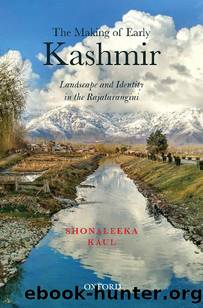The Making of Early Kashmir: Landscape and Identity in the Rajatarangini by Shonaleeka Kaul

Author:Shonaleeka Kaul [Kaul, Shonaleeka]
Language: eng
Format: epub
Publisher: OUP India
Published: 2018-01-08T00:00:00+00:00
chapter four
(Re)locating Early Kashmir
Geoculture of a Region and Beyond
The shared commons that we choose to call a regional way of life is only ever relationally and discursively constituted.
âAsh Amin
Apart from questions of history and landscape, the third main interest behind the textual reinterpretation of the RÄjataraá¹ giá¹Ä« that this book represents is the question of early Kashmirâs cultural location and identity. In other words, we look to understand the regional identity claimed for and by this land, as well as the traditions that shaped this identity, until the early medieval period. A historical regionâa unit of a geographical, political, or cultural characterâis, by definition, a relational term. It can be spoken of in explicit or implicit association or contrast with other regions and, most often, a supra-region. In Kashmirâs case, there is a special need to pose this question of the relational location of the region. That need derives from the main impression that the Valley seems to have left on popular and scholarly imagination, namely that of its isolation,1 a view suggested more by its surrounding high mountain topography perhaps, than by its historical reality attested multiply by all manner of sources, as this chapter will show.
From âisolationâ to âinsularityâ and a consequential âuniquenessâ has been but a short step in the assumptive characterization of ancient Kashmir. Sample this representative statement: âThe Himalayan Valley of Kashmir ⦠[has been] geographically secluded from the rest of South Asia. Its geographic situation, bounded on all sides by high mountains, has led to an insularity that contributed to the development of its unique cultural characteristicsâ (emphasis added).2 This conviction about Kashmirâs splendid, if imaginary, isolation has in turn tied in neatly with ideas of âperipheralityââa notion thought to apply to any region that lay on the outliers of the historical formation that flourished along the Gangetic Valley from the 6th century BCE onwards, which is construed as the âCentreâ.
Peripherality is used to imply a great distance, literal and figurative, from the Centre. That this is itself a view from the Centre, privileging it in historical processes, is not noticed by those looking to ascribe acculturative and hegemonizing tendencies to the relationship between the Indic heartland and everywhere else. This evolutionist position suggests a passivity to outlying regions in their historical emergence and development as also an understanding of cultural processes, mechanisms, and choices as top-down (also hand-me-down), expropriative, static, and unilinear.
A recent study of the NÄ«lamata PurÄá¹a applies this approach to early Kashmir.3 It essentially replays the influential materialist scholarship on the PurÄá¹as, according to the most cogent theoretical statement of which by Vijay Nath, these texts were little more than an acculturative instrument for the imposition of âmainstream civilizationâ and âbrahmanizationâ on âtribal societiesâ to facilitate the spread of agriculture.4 As Christopher Minkowski has put it, this is âas if brahmins were a species of beneficial, exotic plant or insectâ!5 Such a position is also highly reductive of a genre that was essentially an amorphous and heterogeneous compilation of free-floating oral narratives and encyclopaedic materials over centuries.
Download
This site does not store any files on its server. We only index and link to content provided by other sites. Please contact the content providers to delete copyright contents if any and email us, we'll remove relevant links or contents immediately.
| Africa | Americas |
| Arctic & Antarctica | Asia |
| Australia & Oceania | Europe |
| Middle East | Russia |
| United States | World |
| Ancient Civilizations | Military |
| Historical Study & Educational Resources |
Magic and Divination in Early Islam by Emilie Savage-Smith;(1194)
Ambition and Desire: The Dangerous Life of Josephine Bonaparte by Kate Williams(1083)
Operation Vengeance: The Astonishing Aerial Ambush That Changed World War II by Dan Hampton(985)
What Really Happened: The Death of Hitler by Robert J. Hutchinson(867)
London in the Twentieth Century by Jerry White(844)
Time of the Magicians by Wolfram Eilenberger(842)
Twilight of the Gods by Ian W. Toll(810)
The Japanese by Christopher Harding(794)
Papillon by Henry Charrière(792)
Lenin: A Biography by Robert Service(777)
The Devil You Know by Charles M. Blow(777)
Twelve Caesars by Mary Beard(763)
Freemasons for Dummies by Hodapp Christopher;(747)
The Churchill Complex by Ian Buruma(729)
Napolean Hill Collection by Napoleon Hill(700)
The Enlightenment by Ritchie Robertson(690)
Henry III by David Carpenter;(685)
Bohemians, Bootleggers, Flappers, and Swells: The Best of Early Vanity Fair by Bohemians Bootleggers Flappers & Swells- The Best of Early Vanity Fair (epub)(678)
The Rise and Triumph of the Modern Self by Unknown(651)
